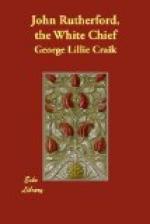knew anything of their god, or ever had any communication with him, they replied that they often heard him whistle. The chiefs, too, are often called atuas, or gods, even while they are alive. The aged chief, Tarra,[BO] maintained to one of the missionaries that the god of thunder resided in his forehead; and Shungie and Okeda[BP] asserted that they were possessed by gods of the sea.
The part of the heavens in which the gods reside is represented as beautiful in the extreme. “When the clouds are beautifully chequered,” writes Kendal, “the atua above, it is supposed, is planting sweet potatoes. At the season when these are planted in the ground, the planters dress themselves in their best raiment, and say that, as atuas on earth, they are imitating the atua in heaven.”
The New Zealanders believe that the souls of the higher orders among them are immortal; but they hold that when the “cookees” die they perish for ever. The spirit, they think, leaves the body the third day after death, till which time it hovers round the corpse, and hears very well whatever is said to it. But they hold also, it would seem, that there is a separate immortality for each of the eyes of the dead person; the left, as before-mentioned, ascending to heaven and becoming a star, and the other, in the shape of a spirit, taking flight for the Reinga. Reinga signifies, properly, the place of flight; and is said, in some of the accounts, to be a rock or a mountain at the North Cape from which, according to others, the spirits descend into the next world through the sea. The notion which the New Zealanders really entertain as to this matter appears to be that the spirits first leap from the North Cape into the sea, and thence emerge into an Elysium situated in the islands of the Three Kings. The submarine path to the blissful region of the New Zealanders is less intricate than that of the Huron of America:—
“To the country of the
Dead,
Long and painful is thy way!
O’er rivers wide and
deep
Lies the road that must be
past,
By bridges narrow-wall’d,
When scarce the soul can force its way,
While the loose fabric totters under it.”
In the heaven of the New Zealanders, as in that of the ancient Goths, the chief employment of the blessed is war, their old delight while on earth. The idea of any more tranquil happiness has no charms for them. Speaking of an assembly of them which he had been endeavouring to instruct in the doctrines of Christianity, one of the Wesleyan missionaries says: “On telling them about the two eternal states, as described in the Scriptures, an old chief began to protest against these things with all the vehemence imaginable, and said that he would not go to heaven, nor would he go to hell to have nothing but fire to eat; but he would go to the Reinga or Po, to eat coomeras, (sweet potatoes) with his friends who had gone before.”
The slaves that are sacrificed upon the death of a chief, by his friends, are generally intended to prevent him from coming again to destroy them; but we find that on the occasion of a child having been drowned, the mother insisted upon a female slave being killed, to be a companion for it on its way to the Reinga.




